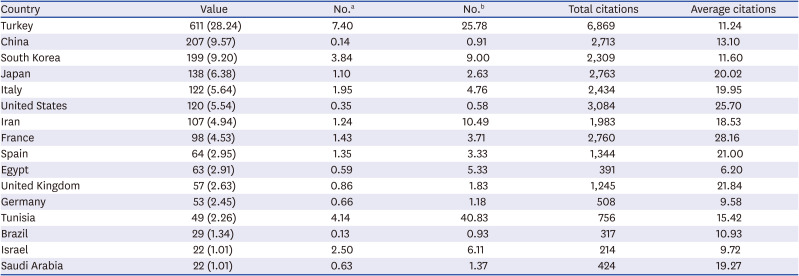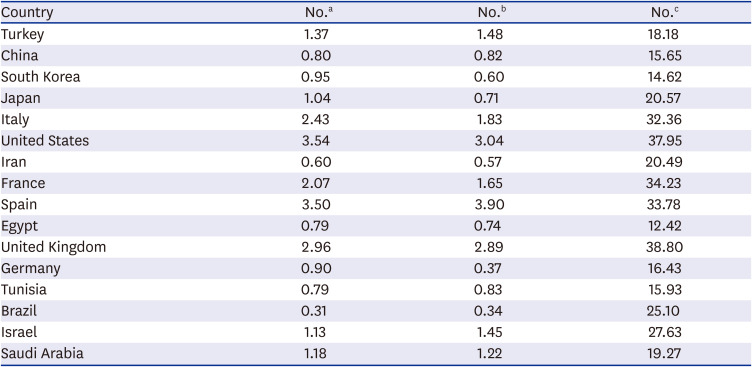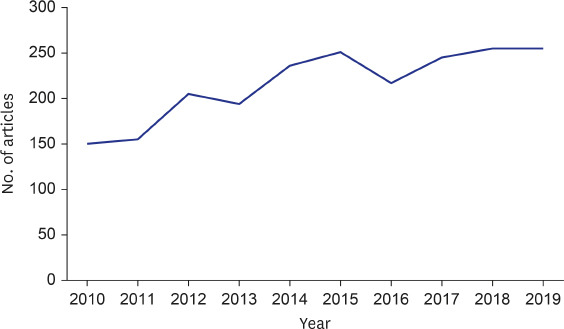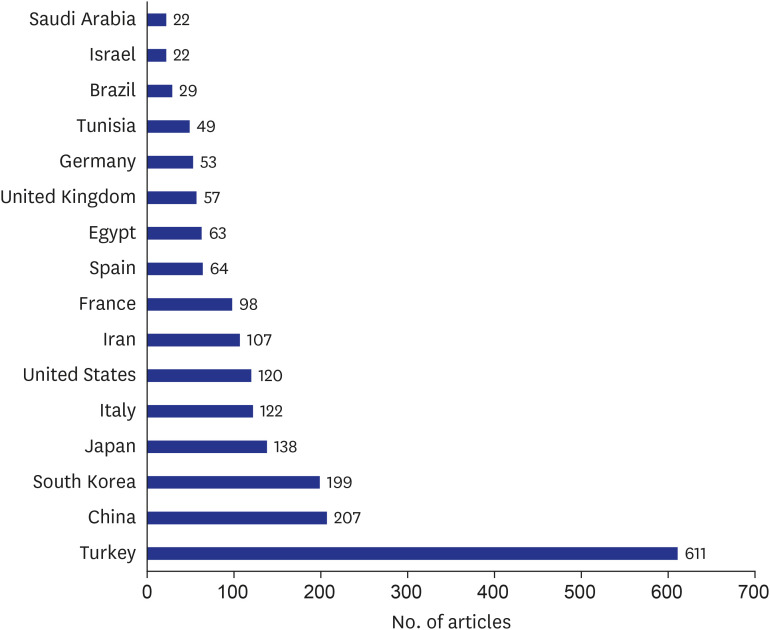INTRODUCTION
Behcet's disease (BD) is mainly a systemic vasculitis that affects various vessel types and different sizes of vascular structures. As a result of systemic inflammation, oral-genital ulcers, ocular, cerebral, and gastrointestinal disorders can accompany the clinical presentation.
123 BD has a geographic distribution and is more common in countries along the route known as the ancient Silk Road. The spread of various genetic factors, including HLA-B51, along this route, may trigger the emergence of such a distribution.
45
Bibliometric analysis is an approach used to assess scientific productivity on a particular subject within a strictly specified date range.
6 Studies based on bibliometric analysis present a substantial snapshot of the global scientific contribution to the literature on a specified topic.
7 These studies provide summarized information, including high-impact papers, the most productive countries, the most active journals, and leading authors and institutions. In the light of the basic information obtained from the bibliometric analysis, gaps that should be taken into consideration in future research can be determined.
8 As a result of the widespread use of the Internet and the increasing use of social media platforms in all areas of life, alternative article metrics (altmetrics) have started to be used frequently in measuring the academic and social impact of articles.
910 Various Internet-based tools allow the rapid following of the social impact of a scientific publication by evaluating the shares on social media, comments on YouTube, Facebook, Twitter and mentions in news outlets and on academic platforms.
11
Bibliometric studies have been conducted in various fields and topics, including rheumatology.
12131415 A previous study evaluated BD articles published between 1980 and 2014 but did not include altmetric analyses.
16 Therefore, the aim of this study was to analyse BD articles published between 2010–2019 bibliometrically and present up-to-date data, and to offer a different perspective using altmetric analyses.
Go to :

DISCUSSION
Bibliometric studies provide extensive information about global publication productivity, trends over the years, the status of countries, and citation data. Altmetric analyses reveal the individual impact of scientific articles via the internet and various social media platforms. The results of this study demonstrated an increasing trend in the number of articles on BD from 2010 to 2019, which suggests ongoing scientific development in the field of BD. More than 90% of the articles were provided by high and upper middle-income countries. Taking into consideration the positive influence of economic development on scientific production, this can be evaluated as an expected result. Nevertheless, it also suggests that lower middle-income and low-income countries should be supported in terms of scientific productivity.
The five most productive countries were Turkey, China, South Korea, Japan, and Italy, respectively. Turkey also dominated this area in terms of the number of articles. The rising trend that China gained in the contribution rate after 2011 cannot be ignored. The high prevalence of BD in these countries, with the effect of geographic distribution, as well as the historically high awareness of BD among physicians in these countries may have led to this result.
When the number of articles was adjusted according to population, Turkey, Tunisia, and South Korea were in the top three. Despite the large population size, Turkey was the first in terms of the number of articles with a major difference, and relatively low population size was effective for Tunisia and South Korea.
In calculations based on GDP, Tunisia, Turkey, and Iran were ranked as the first three. Despite the relatively low GDP of these countries, the high number of articles produced with geographic influence may explain this result. For the average number of citations per article, the top three countries were France, the United States and, the United Kingdom. Although they produced a relatively low number of articles as they are geographically not a part of the Silk Road, these countries provided high-quality articles as a result of their general scientific development. High research budgets allocated to this field and accurate use of human resources may have also contributed to this result.
The number of articles sourced from high-income countries was divided by the number of articles sourced from countries in other GDP groups, and although a ratio of 9/1 (in favor of high-income countries) has been reported in similar bibliometric studies,
29 the current study results do not support this ratio. The high number of articles originating from Turkey and China, in particular, prevented reaching this ratio.
Although more than three-quarters of the papers were original articles, reviews reached a higher value in terms of average citation per article. This can be attributed to the fact that BD can be presented more comprehensively with all aspects in reviews.
The vast majority of journals publishing BD articles were indexed in SCIE. In addition, there was a considerable difference in favor of SCIE journals in the average number of citations per article (15.95 for SCIE journals and 3.85 for ESCI journals). These results show that ESCI journals have a long way to go, both qualitatively and quantitatively. When SCIE journals were evaluated in terms of Quarters, the lowest publication rate was found in Q1 journals. This can be explained by the fact that the articles were not at the level to be published in top-class journals and that Q1 journal editors do not give priority to this field.
The five most active journals in terms of the number of articles on BD were ranked as Clin Exp Rheumatol, Clin Rheumatol, Ocul Immunol Inflamm, Rheumatol Int, and Int J Rheum Dis, respectively. It was noteworthy that four of the five journals were primary rheumatology journals, which could be due to the fact that rheumatology journals prioritize BD articles rather than ophthalmology, dermatology, and immunology journals. In addition, authors may have preferred to publish in rheumatology journals. The five most active countries in these five journals were identified. Turkey ranked first in Clin Exp Rheumatol, Clin Rheumatol, Ocul Immunol Inflamm, and Rheumatol Int, and Iran was first in Int J Rheum Dis. As Turkey produced a high number of articles, this cannot be considered a surprising result. Significant and weak correlations were found between the number of citations and AAS and tweet counts. In addition, the number of citations was significantly and strongly correlated with MRC. Mendeley users are generally researchers specialized in certain areas utilizing the online reference network. Researchers add publications to their library on the Mendeley platform and potentially cite them in future articles. Therefore, MRC increases before the number of citations and can be considered as an accurate reflection of future citations.
In contrast, AAS is calculated based on current interactions sourced from social media platforms, news, policy documents, and blogs, etc. Therefore, it reflects the individual users' effect rather than professional researchers. This can explain the weak correlations between AAS - tweet counts and citation data. Despite this weak correlation, it can be recommended that the altmetric values and standard bibliometric analyses be accepted as complementary elements to determine the whole impact of the articles.
Rheumatol Int was the journal ranked first in the average AAS per article and average tweets count per article. Clin Rheumatol was the first and Rheumatol Int was the second in respect of average MRC per article. The active use of social media and other internet platforms by Rheumatol Int editors may have led to this result. Furthermore, the articles published in Rheumatol Int may have attracted more attention from individual internet users.
One of the limitations of this study was that only the WoS database was used. Results may differ in other databases such as Scopus, Pubmed, and Google Scholar. However, when it is considered that WoS is the most preferred database in bibliometric-altmetric analyzes, there is established literature on the use of WoS in this study type, and the reputation and reliability of WoS among researchers, this was not thought to be a substantial deficiency. Only articles in English were included in the study and the date range was limited to 2010–2019. As a previous study evaluated articles on BD between 1980–2014,
16 the 2010–2019 date range was selected to update the data and to present a different perspective. Self-citations were not assessed or removed. Despite the aforementioned limitations, this article also has various strengths. A comprehensive, systematic, scientific, and objective research methodology was used and bibliometric and altmetric analyses were combined. Therefore, up-to-date data are provided on worldwide publication productivity in the BD field.
In conclusion, global productivity increased in BD articles from 2010 to 2019, and there was determined to be consistency between the article productions of the countries and the ancient Silk Road routes. Rather than prominent countries in terms of article production, France, the United States, and the United Kingdom were at the forefront in respect of average citations per article. The relationship between altmetric data and standard bibliometric analysis was not completely consistent. Therefore, it can be suggested that bibliometric and altmetric analyses be considered as complementary to each other.
Go to :










 PDF
PDF Citation
Citation Print
Print






 XML Download
XML Download